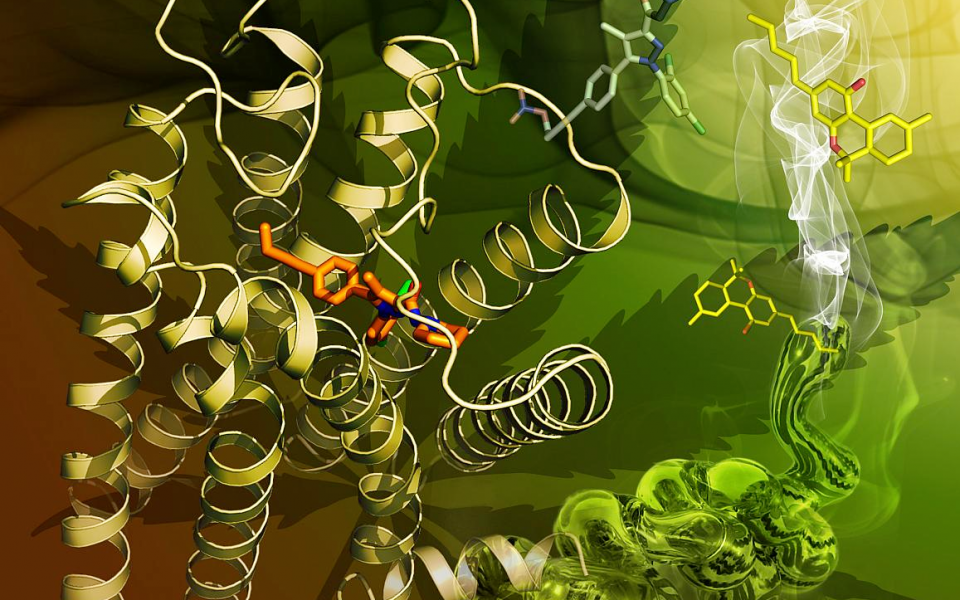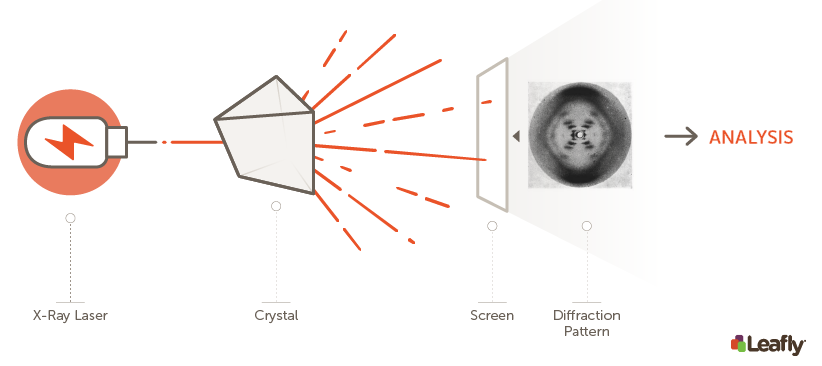An international team of scientists from the United States and China recently made headlines by publishing a paper detailing the crystal structure of the human cannabinoid receptor type 1 (CB1). This is a major discovery, as the CB1 is responsible for THC’s euphoric “high” as well as some of its therapeutic applications. Knowing the crystal structure gives scientists a detailed 3-D picture of what the CB1 receptor looks like and how cannabinoids like THC physically interact with it to exert their effects. But why is this discovery so important to the future of medicine, and how did scientists manage to crack the riddle of its crystal structure?
What is the CB1 Receptor and How Does It Work?
 Crystal structure of the human CB1 receptor. The twisted ribbon structure in the foreground depicts the molecular structure of the CB1 receptor, as determined by X-ray crystallography (explained below). THC, the psychoactive component of cannabis, is depicted on the side as yellow sticks. Photo credit: Yekaterina Kadyshevskaya, Stevens Laboratory, University of Southern California.
Crystal structure of the human CB1 receptor. The twisted ribbon structure in the foreground depicts the molecular structure of the CB1 receptor, as determined by X-ray crystallography (explained below). THC, the psychoactive component of cannabis, is depicted on the side as yellow sticks. Photo credit: Yekaterina Kadyshevskaya, Stevens Laboratory, University of Southern California.
There are two major cannabinoid receptors that we currently know about: CB1 and CB2. The CB1 receptor is found primarily in the nervous system, whereas CB2 is found largely in the immune system (but you can find it in the brain, too). These two receptors are major players in our endocannabinoid system, which plays a key role in regulating how active our nervous systems are.
CB1 receptors are some of the most abundant receptors in the brain, and multiple cannabinoids depend on this receptor in order to exert their effects. For example, the major psychoactive component of cannabis, tetrahydrocannabinol (THC), activates the CB1 receptor. Without the CB1 receptor, cannabis would pretty much have no psychoactive effects. This also explains why non-psychoactive cannabinoids, like cannabidiol (CBD), don’t get you high. CBD does not activate the CB1 receptor like THC does.
Even for non-cannabis consumers, the CB1 receptor is important to know about for a couple of reasons. First, improper functioning of this receptor has been linked to a variety of health problems and disease states. Second, the CB1 receptor is activated by the body’s major endogenous cannabinoids. In contrast to plant cannabinoids like THC, endocannabinoids are produced naturally within the body, which is how they get that name (“endogenous” = “produced within”). The two major endocannabinoids are anandamide and 2-AG, both of which activate the CB1 receptor.
But while we’ve known about CB1 receptors and their importance for years, we haven’t actually had a detailed picture of what this receptor looks like. Until now.
CB1 Receptor Crystal Structure: Why Should We Care?
 Protein crystals. This picture depicts a variety of protein crystals. The physical properties of each crystal, such as color, depend on the structure of the protein molecules that it is composed of. Protein crystals such as these can be used in X-ray crystallography experiments (explained below) to deduce the structure of the protein molecules.
Protein crystals. This picture depicts a variety of protein crystals. The physical properties of each crystal, such as color, depend on the structure of the protein molecules that it is composed of. Protein crystals such as these can be used in X-ray crystallography experiments (explained below) to deduce the structure of the protein molecules.
When scientists solve the crystal structure of a protein like the CB1 receptor, it means they have a high-resolution, 3-D picture of the molecular details of that protein, down to the level of single atoms. To obtain a picture this detailed, scientists use a technique called X-ray crystallography, and it’s pretty trippy.
First, scientists take a purified solution of a protein, like CB1, and crystallize it. The crystals they obtain consist of a highly-ordered arrangement of the protein or molecule of interest. For technical reasons, getting high-quality crystals is really, really hard. Proteins such as brain receptors are big, bulky, and complicated. This makes it difficult to obtain good crystals for things like the CB1 receptor. That’s the “crystallography” part. Next step: X-rays.
Once scientists have high-quality crystals, they hold them in front of a high-intensity X-ray beam. As a crystal is bombarded with X-rays, it scatters them onto a screen behind the crystal, creating a diffraction pattern. The pattern created depends on the shape of the protein. Two different crystals, made from proteins with different shapes, will create distinct diffraction patterns. The most famous diffraction pattern in the history of science is the one that led to the discovery of the double-helix structure of DNA.
 How X-ray crystallography works. After purifying and crystallizing the protein or biological molecule of interest, scientists bombard them with high-intensity X-rays. The X-rays are diffracted through the crystal, creating a unique diffraction pattern that depends on the structure of the molecules within the crystal. This diffraction pattern is then analyzed to determine their physical structure. The diffraction pattern shown here, known as Photo 51, was the original image used to figure out the double-helix structure of DNA. It is not the diffraction pattern that was used to figure out the CB1 receptor structure.
How X-ray crystallography works. After purifying and crystallizing the protein or biological molecule of interest, scientists bombard them with high-intensity X-rays. The X-rays are diffracted through the crystal, creating a unique diffraction pattern that depends on the structure of the molecules within the crystal. This diffraction pattern is then analyzed to determine their physical structure. The diffraction pattern shown here, known as Photo 51, was the original image used to figure out the double-helix structure of DNA. It is not the diffraction pattern that was used to figure out the CB1 receptor structure.
After getting the diffraction pattern, scientists can use it to figure out the molecular structure that created the picture. In this new study, they did it for the human CB1 receptor, providing a detailed picture of what the receptor actually looks like. Before this, our picture was much fuzzier. The details of a crystal structure allow us to visualize how a molecule like THC physically interacts with the receptor, and come to a deeper understanding of the mechanisms that allow it to have its effects.
The other reason that having a detailed crystal structure is important is that it allows scientists think about the custom design of therapeutic compounds that might interact with the receptor. Without a crystal structure, the design process involves a lot more guesswork; with a crystal structure, chemists can start to design compounds that interact with specific parts of the receptor to achieve very specific effects. This is only possible with the crisp picture that the crystal structure provides, so a breakthrough like this holds massive promise for the development of new cannabis-based medicines going forward.
References
Di marzo V. Targeting the endocannabinoid system: to enhance or reduce? Nat Rev Drug Discov. 2008;7(5):438-55.
Hua T, Vemuri K, Pu M, et al. Crystal Structure of the Human Cannabinoid Receptor CB1. Cell. 2016;167(3):750-762.e14.
Mechoulam R, Hanuš LO, Pertwee R, Howlett AC. Early phytocannabinoid chemistry to endocannabinoids and beyond. Nat Rev Neurosci. 2014;15(11):757-64.
Mechoulam R, Parker LA. The endocannabinoid system and the brain. Annu Rev Psychol. 2013;64:21-47.


